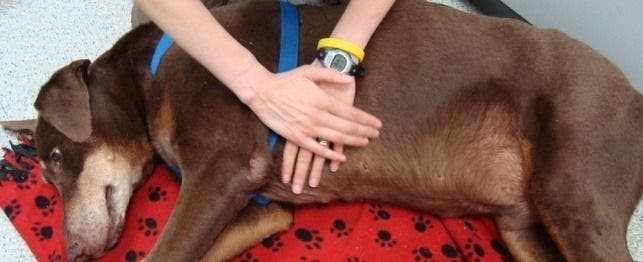
Pet Emergency Course: CPR
In the event of an emergency, your pet’s life may depend on your quick recognition of the situation, your knowledge of pet first aid, and the way in which you respond to the emergency.
CPR, or cardiopulmonary resuscitation, is the act of artificially circulating blood and oxygen throughout the body during cardiac and respiratory arrest. Minutes without blood and oxygen can cause irreversible damage to the tissues and organs of the body; therefore, quick reaction is crucial.
Cardiopulmonary arrest, or the cessation of breathing and heartbeat, can be caused by many traumas, diseases, and disorders. If you feel an animal is in cardiopulmonary arrest, confirm this by speaking to the pet, touching him, and trying to arouse him. If you begin CPR on an animal that is not in arrest, you could become injured. Watch for the rise and fall of the animal’s chest to determine if he is breathing. If there are no breaths for 10 seconds, STAY CALM and begin CPR.
ABC’s of CPR
Airway, breathing, and circulation are the ABC’s of CPR. These three building blocks of resuscitation are to be established in this order. If possible, have two or three people available to perform CPR.
Airway
Before giving artificial respirations, check the pet’s airway (mouth and throat) to determine that it is open and clean. Lay the pet on his side, extend his head, open his mouth, and pull out the tongue. Check the airway for any obstructions (e.g. a ball, stick, meat chunk, vomit, etc.).
If anything is seen or if the airway is too dark to visualize, perform a finger sweep. Run your index finger into the pet’s mouth along the cheek and across the back of the throat. Deep in the throat is a structure called the hyoid bone, which you are unlikely to encounter. You should be aware of this though, and do not pull on it.
If an object is lodged in the throat, you can perform 5-10 abdominal thrusts (as in the Heimlich maneuver performed on humans) to try to dislodge the foreign body. If this works, the pet may regain consciousness on his own, or CPR may still need to be administered.
It is also possible that the airway can become blocked due to swelling. In this case, the pet needs to be treated by a veterinarian immediately.
Breathing
When the airway is free and clear, artificial respirations can be started if the animal is still not breathing. With the animal lying on his right side, extend the neck, pull out the tongue, and hold the mouth closed tightly over the tongue.
Place your mouth around the animal’s nose, or nose and mouth, depending on the size of the patient. Create a seal with your lips and/or hand. Give two breaths, watching for the chest to rise and the lungs to expand fully. Be careful not to overinflate, especially in small animals. Expiration (or breathing out) is a passive process; allow this to occur after each breath.
After two breaths, watch for the pet to begin breathing on his own. If there is no response from the pet, continue artificial respirations at a rate of 12-20 breaths per minute for large pets and 20-25 times per minute for small pets. While watching for breaths, you should also feel the pet’s chest near his left elbow to check for a heartbeat. If the heartbeat is absent, cardiac compressions should begin.
Circulation
In pets under 10 pounds, use your dominant hand to grasp the pet around his chest (thumb on one side, 4 fingers on the other) and squeeze 100-150 times per minute. You can also use the ball of your hand to compress the chest of a small pet that is more than 10 pounds, while using your non-dominant hand to support the pet’s back and prevent him from sliding with compressions. Compress the chest by about 25-33% of its diameter.
In medium and large dogs, use one or two hands (depending on patient and rescuer size) to compress the widest part of the chest by 25-33% of its diameter. Do this 80 -120 times per minute. Lean over the dog, and compress with your elbow(s) locked to deliver optimal force.
If preferred, compressions can also be performed on medium and large dogs with the patient on his back. In this case, deliver compressions over the sternum (or breastbone).
Coordinating Artificial Respirations and Chest Compressions
If there is only one rescuer available to resuscitate the patient, give two breaths after every 15 compressions. If multiple rescuers are available, breaths should be administered during compressions at a rate of one breath during every second or third compression.
Veterinary Care
If possible, the pet should be transported to a veterinarian during CPR. If the patient recovers with your resuscitation efforts, he should still be seen by a veterinarian as soon as possible, as follow-up care may be needed.
Is Pet Insurance Right for you?
The best pet insurance offers coverage that’s broad enough for whatever care your pet needs and with enough options to get the perfect coverage for you and your pet.
Are you pet crazy? Sign up for our email newsletter and get the latest health and wellness info, useful tips, product recalls, fun stuff, and so much more!